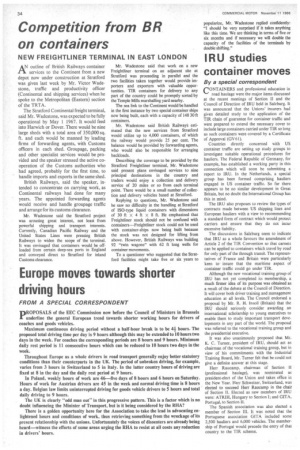IRU studies container moves
Page 36

If you've noticed an error in this article please click here to report it so we can fix it.
By a special correspondent rONTAINERS and professional education in road haulage were the major items discussed at the recent meetings of Section II and the Council of Direction of IRU held in Salzburg. It was announced that the Unions' insurers had given detailed study to the application of the TIR chain of guarantee for container traffic and were prepared to extend the necessary cover to include large containers carried under TIR so long as such containers were covered by a Certificate of Approval (GV 61).
Countries directly concerned with US container traffic are setting up study groups to investigate suitable operational procedures for hauliers. The Federal Republic of Germany, for example, has established a working party in this connection which will soon be submitting a report to IRU. In the Netherlands, a special group has been formed comprising hauliers engaged in US container traffic. So far there appears to be no similar development in Great Britain, but no doubt the International Group has this in mind.
The IRU also proposes to review the types of contracts made between US shipping lines and European hauliers with a view to recommending a standard form of contract which would protect carriers and ensure that they do not incur excessive liability.
The discussions in Salzburg seem to indicate that IRU as a whole favours the amendment of Article 2 of the TIR Convention so that carnets can be applied to containers which travel by road for only part of the through transit. The representatives of France and Britain were particularly keen to insure that the maritime aspect of container traffic could go under TIR.
Although the new vocational training group of IRU has not yet completed its membership, a much firmer idea of its purpose was obtained as a result of the debate at the Council of Direction. It will cover both driver training and management education at all levels. The Council endorsed a proposal by Mr. R. H. bison .(Britain) that the IRU should seriously consider awarding an international scholarship to young executives to enable them to study important transport developments in any part of the world. The proposal was referred to the vocational training group and the presidential executive.
It was also unanimously proposed that Mr. K. C. Turner, president of IRU, should act as chairman of the vocational training group, but in view of his commitments with the Industrial Training Board, Mr. Turner felt that he could not give a definite answer at this stage.
Herr Raucamp, chairman of Section II (professional haulage), was nominated as president-elect of the Union and takes office in the New Year. Herr Schweizer, Switzerland, was elected to succeed Herr Raucamp in the chair of Section 11. Elected as new members of IRU were: ATRIH, Hungary to Section I; and GITA, Portugal, to Section II.
The Spanish association was also elected a member of Section III. It was noted that the Portuguese association GITA included some 2,500 hauliers and 6,000 vehicles. The membership of Portugal would precede the entry of that country to the TIR scheme.
































































































































